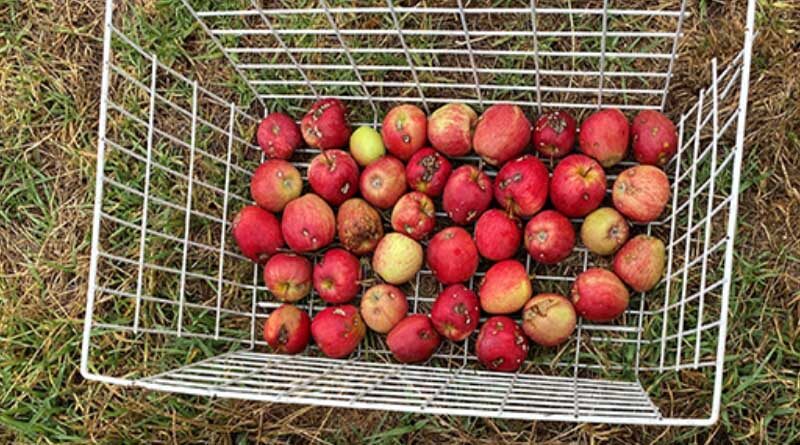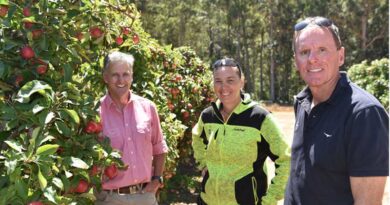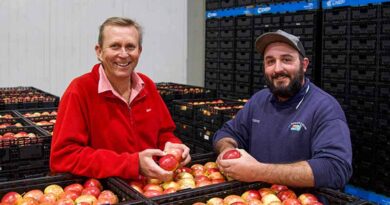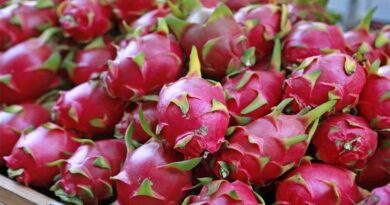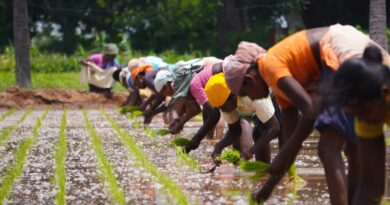New era in pest control for Adelaide Hills orchards
24 August 2021, AU: The Ceravolo Orchards enterprise comprises about 90 hectares of apples, 10 – 15 ha of cherries and 5 – 10 ha of pears over properties at Ashton, Woodside, Nairne and Echunga.
Apple yields can range from 65-70 t/ha down to 50-55 t/ha from younger trees, with most fruit sold locally. The Ceravolos also operate a juicing line, processing their third-grade fruit, as well as fruit from other local growers.
They target 80 per cent premium fruit pack-out to maximise returns and that means minimising damage from weather events and pests as much as possible.
Joe said codling moth is one of the major pests to manage in their orchards, as well as woolly apple aphid and weevils, thrips and dimple bug in select areas and seasons.
Also Read: Beyond the Vine: Breeding Better Grapes
He said codling moth damage could easily cause a 50pc fruit loss if not controlled or managed effectively.
Image: Pictured (top) are apples from a block infected by weevils at Ceravolo Orchards’ Ashton property compared with apples (below) from an adjacent block that was treated with the new Vayego insecticide from Bayer.
“Even if it gets away from you, it is best to get it under control in that year if you can, which becomes very expensive with the added chemicals and variety of chemistry, but otherwise it is twice the battle the next year,’’ Joe said.
The family traditionally used Gusathion insecticide, when it was available, but has since had a strong focus on using IPM-friendly products, also to minimise mite “flare-ups’’.
“We are very cautious about which chemicals we apply. We try to use as many IPM-friendly chemicals as we can. It pays in the long run – not having flare-ups with any mites. We haven’t used a miticide in 12-15 years,’’ Joe said.
“We put up with a little bit of pest pressure, but there are limits and tolerances and once we exceed those, we do something about it.’’
In recent years, Altacor® insecticide has mostly been used against moths, up until Joe was introduced to the new Vayego® insecticide at a grower education session hosted by his local supplier.
Joe said the education sessions were invaluable to ensure confidence in products and their effective application.
“We had that confidence with Vayego, he said.’’
Image: Bayer Territory Business Manager Darren Alexander and Adelaide Hills fruit grower Joe Ceravolo discuss pest control and the latest Vayego insecticide at the family’s Ashton property.
Vayego contains the new fast acting and long-lasting active ingredient, tetraniliprole, developed by Bayer, providing breakthrough selective control of various moth, weevil, beetle and fly pest species in pome fruit, stone fruit, almonds and macadamias.
Its systemic action and residual efficacy targets multiple life stages, causing rapid feeding cessation to minimise damage, while, importantly, it is soft on many beneficial species and offers a short withholding period.
Vayego comes as an easy-to-use liquid formulation and also is widely compatible, rainfast and has shown strong performance under various conditions.
“If new chemistry and actives come in and it’s IPM-friendly, it’s something we usually consider straight away to ensure we get good control over that pest in the orchard,’’ Joe said.
“With older products, there’s always the risk of resistance if you use them constantly year after year – and we certainly don’t want to lose chemistry along the way if we can help it.
“Vayego is a nice liquid formulation that is simple to use and it controls a few more pests other than codling moth. It also controls weevils, which have been a problem in certain orchards and crops for probably 20-30 years and are a massive issue for us in cherries.
“We’ve never had a product to spray on trees that control weevils, so it’s certainly something I’ll be looking to put into certain blocks and will be further investigating it in cherries.’’
Image: Darren and Joe sample the family’s juicing line range, marketed under their Ashton Valley Fresh brand.
Bayer Territory Business Manager Darren Alexander said having an IPM-friendly product that targeted both codling moth and weevils was a bonus for growers.
“Often when growers are going out to spray, they need to target more than one pest. Compared with non-specific, harsher chemistry of times gone by, IPM-friendly products can be more specific, targeting one pest species like moths or beetles, so to have an IPM-friendly product that targets both codling moth and weevils is a great advantage,’’ Darren said.
Joe said Vayego was applied early in the season predominantly for codling moth control alongside untreated blocks that also became infected with weevils.
It was applied at a rate of 10 mL per 100 L of water, together with fungicide and calcium fertiliser, using a 1000 L tow behind air mist sprayer.
“Codling moth control was excellent and the weevil control in the block was excellent as well. We had a look at the fruit and it was obvious. In certain places of the other block, there would have been about 30pc damage to some of the fruit from weevils. It can vary, but any more than 5pc damage on fruit is a problem. Hence, I’m very confident with the product for the control of weevils,’’ Joe said.
The Ceravolos strive to achieve 100pc codling moth control and so generally use isomate products as well as two to three insecticide applications.
“Usually it is three Altacor sprays, but we just used one in the block where Vayego already had been applied,’’ Joe said.
He expects Vayego will be used early in his pest program in the future.
“It will be used to control weevils and codling moth in areas where I have a problem. And I’ll be trialling it in the cherries this year, probably as an early spray. Early control of insects is better than waiting for numbers to build up, when they can become too hard to control,’’ Joe said.
He said maintaining the beneficial insect population by using Vayego was another big benefit.
“A product like Vayego doesn’t disturb that beneficial insect population. Once you’ve disturbed it, it’s very hard to get back.’’

